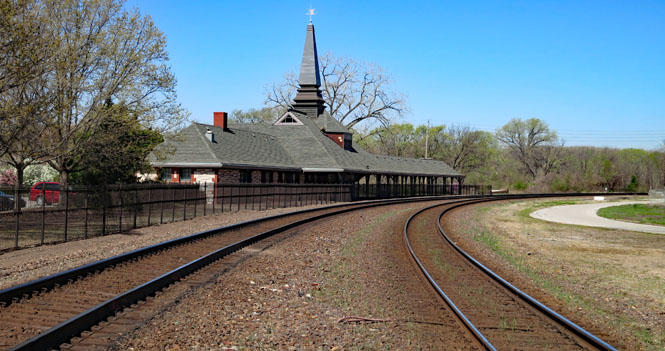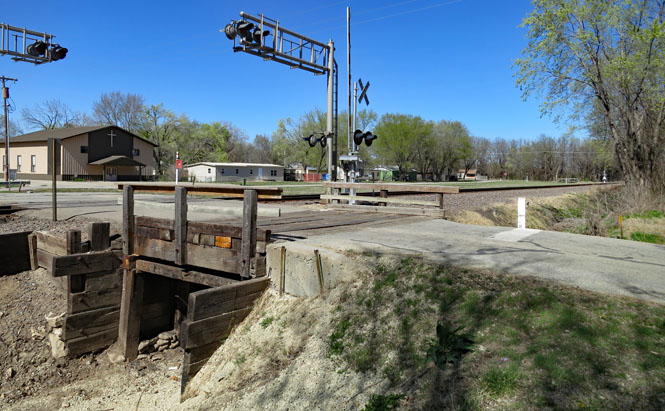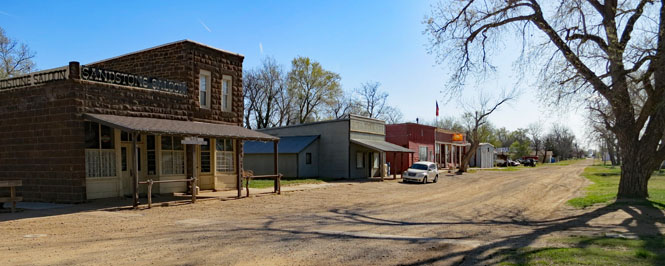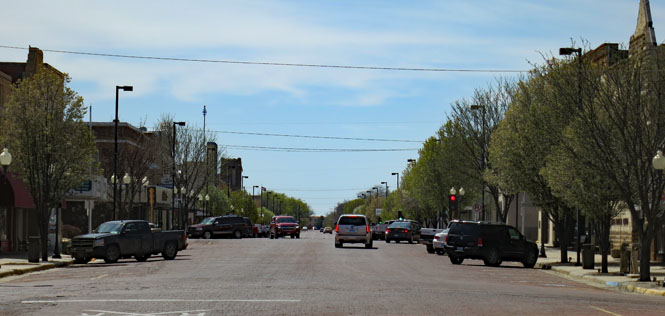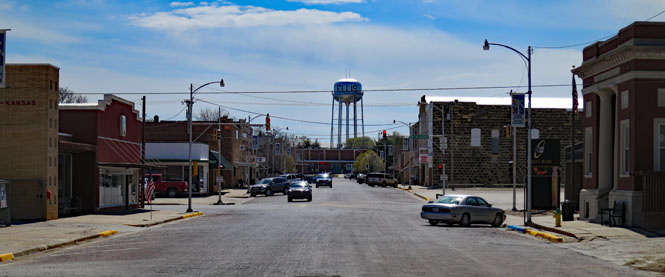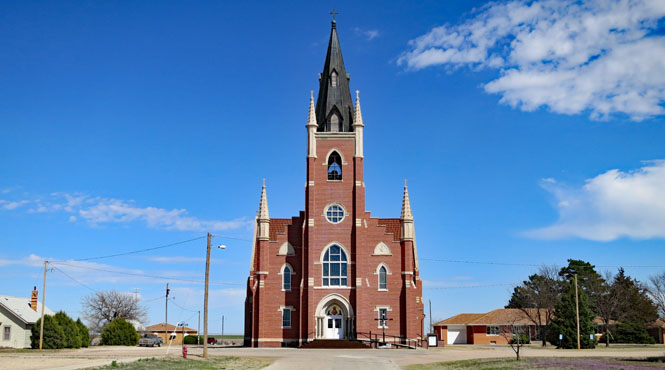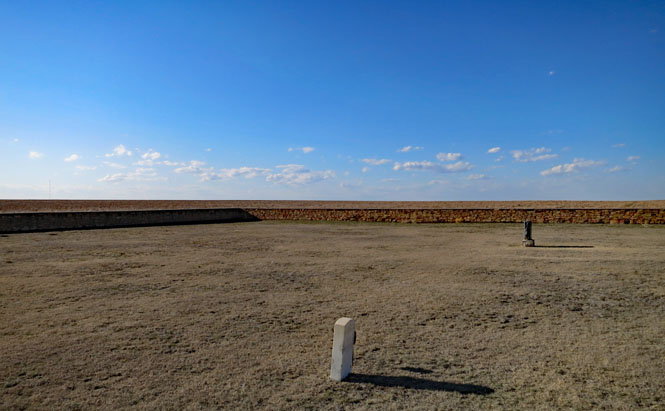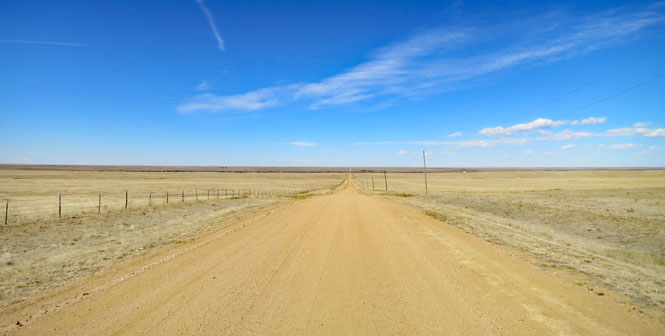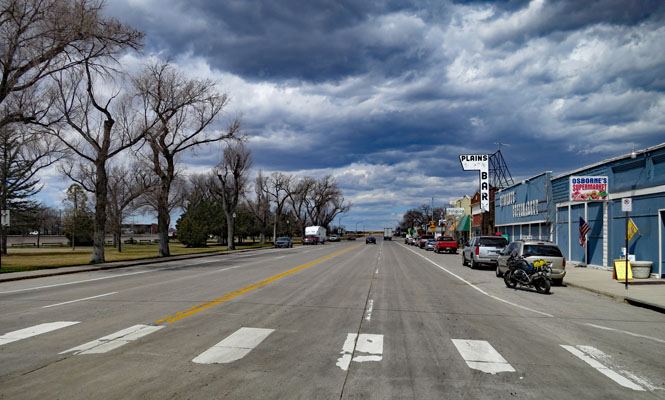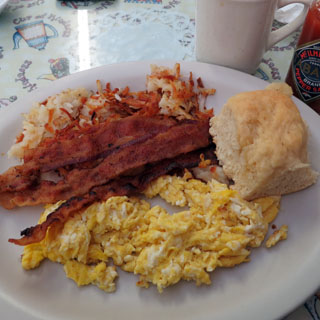April, 2016

The Kansas-Pacific Railroad was crucial to the settlement of Kansas and the Great Plains. By 1870 the line was completed between Kansas City and Denver, finally linking both coasts by a transcontinental rail*.
I'll be riding the full length of that historic line, hitting every depot and town along the way (at least, the ones that existed at that time).
The Kansas-Pacific was chartered by the United States and included twenty miles of land extending each side of the proposed rails that would then be sold by the company to fund construction, in addition to bonds that it would also issue. The towns in the map (below) are often fanciful, and never existed and never would. Others are now under different names. I'll do my best to find them.
* The more famous joining of the Union Pacific and Central Pacific at Promontory, Utah (May 10, 1869) still required a ferry crossing at the Missouri River.

Construction began in 1863, laying rails west from Kansas City, during which the company was confusingly called the Union Pacific Eastern Division (even though there was no connection to the Union Pacific Railroad). The name would change in 1869 and then several years later would become part of the Union Pacific (as it is, today).


(it might not really have been built by bullets, dynamite and blood-stained spikes)
I'll be following a list of towns provided by the Kansas Heritage Group (a non-profit). In most cases, the towns still exist under their original name. A few have a new name; the rest are gone--perhaps surviving only by the name on a dirt road.
The route was called the "Golden Belt Route." This is useful to know as frequently I'd find myself riding next to the rails on Golden Road. The old highway that later followed the rails was also called the Golden Belt Route before U.S. highways were assigned uniform numbers.
 Missouri
Missouri
The current Union Station in Kansas City replaced a rather ornate building in a different location. But, even that older station would not have been built to serve the Kansas-Pacific. Back before even the concept of a Union Station was thought of, each competitor railroad had its own station--creating a real headache if you needed to transfer across lines.
But, no matter; let's begin here. This is Union Station, looking east...
...and an older view, looking west. Amtrak serves the station today, but two trains each day is trivial compared to the traffic it saw during the boom years before the war.

Two locomotives are working hard bringing a coal train through the city. There's another engine at the rear. There are fewer tracks than there once were, and none are under cover as is shown in the above image.
 Kansas
Kansas
Muncie is the first station outside Kansas City. These days, of course, the region is still part of the Kansas City metropolitan area. Across the tracks is a large factory (The Griffin Wheel Company) that makes railcar wheels--and has been doing so since 1877.
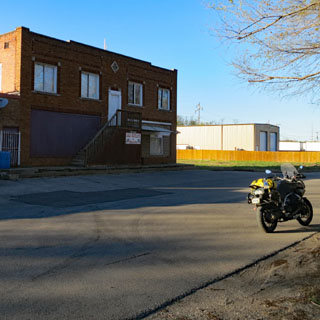
Edwardsville, Kansas. Edwardsville is typical of many of the towns seen along the way. It hardly exists anymore. Often times, the street that crosses the tracks will still retain the name of the town, but that's sometimes all that is left.
Forest Lake, Kansas. Curiously, nearby is a bedroom community with the more fanciful name of "Lake of the Forest." I wonder why it was changed? At any rate, there's not much to say of Forest Lake, today.

Sunflower, Kansas. The old maps are full of nice sounding towns with names like "Sunflower." Did this ever really exist (beyond the probable station)? I found nothing.
Bonner Springs, Kansas.
In almost every case, the road that parallels the track will be called "Front Street." The primary road perpendicular to the track is "Main Street." There are a few choices to name the roads that parallel Main Street. Using names of trees is very popular, and U.S. presidents (starting with Washington) is also common. Least imaginative is to use A, B, C, etc. The streets parallel to Front Street are generally just numbered (leaving out 1st street, of course). It's a standard "T" layout, and makes getting around a town as easy in one as the next.
Following Golden Road. Throughout the ride, I'd find myself on Golden Road. This is a holdover from the Golden Belt highway that paralleled the tracks. When highway numbers were assigned, the Golden Belt highway became U.S. 40 (at least in Kansas and Colorado).
Following the Kansas River. Of course, a river was the original pathway through the Great Plains long before the railroad. The route of the railroad was mostly defined by available water and low grades--but avoiding being flooded during high water.
De Soto, Kansas for breakfast (this town is not on the railroad, but I've got to eat someplace).


Lenape, Kansas (was Armstrong). Why did some towns change their name from what was assigned by the railroad? Very likely, the post office objected to duplicate or similar names.
The Armstrong roundhouse. Something might remain, but perhaps it's just a soybean field, now. You can see something of the town roads in Lenape, but those are little more than driveways to the occasional house. Unless you knew, you would not even think this was a town.

Linwood, Kansas.
Fall Leaf, Kansas (was Horne). The dirt road I was on was called Fall Leaf Road, so I knew I was on the right track (so to speak). There were a few houses, but nothing of any town remains.
The Kansas River is never far away.
Lawrence Junction, Kansas (reached November, 1864). Often, while the railroad followed the north side of the Kansas River, the towns (the ones that thrived, anyway) developed on the south side. This left the stations somewhat isolated from the core of the town--at least until the Santa Fe railroad built their tracks on the south side of the river. That's the case for the college town of Lawrence. It's nice to see the station still here, however, even if it's no longer part of railroading.

Midland, Kansas. Midland still has a feed store / gas station under that name. The school has clearly been used for something else for many years.

Buck Creek, Kansas. You perhaps cannot tell in the photograph, but one of the buildings at the end of the dirt road still has a sign that says "Buck Creek." The town is now just part of the private ranch house and out-buildings.
I gather that this bridge crosses over Buck Creek.

Williamstown, Kansas. The paved Main Street ends at the track. As is almost always the case, there is no station building left--just open space where it once was.
Perry, Kansas.
This obelisk was erected in 1930 by a son in memory of his mother. Why this and why here? I have no idea.
Medina, Kansas. I'm on Medina Road, and I'm quite sure that those few buildings are part of what was once the town of Medina.
Newman, Kansas. It looks like Front Street and Main Street have been named (perhaps renamed?) Newman Lane and Newman Road--seems a bit confusing to me
Grantville, Kansas.
Notice the same bridge is seen in this vintage photograph of Grantville.

Topeka, Kansas (reached in 1865). The Great Overland Station survives, but is now fenced off from the rails. Today's Amtrak follows the old Atchison Topeka and Santa Fe rails and its (far smaller) depot is on the south side of the river.


A grain train crossing the Kansas River while I wait to cross the rails. We'll stay on the north side.
Grain accounts for much of the rail traffic you'll see, today--that, and coal. A hundred-car train looks to be carrying an unimaginable amount of wheat until you see it next to this elevator (look to the left of the photograph). How many rail cars to fill all of this? And, there are many others just like this one.
Menoken, Kansas. The road remains; that is all.

Silver Lake, Kansas.
Kingsville, Kansas. I'm not sure if that building in the background was ever part of Kingsville--perhaps. Certainly, any sign of the old station is gone.

Rossville, Kansas.
St Mary's Mission. The mission predates the current town of St. Mary (it was founded in 1847 as a Jesuit mission along the old Oregon Trail). This memorial arch that commemorates World War 1 dead gives an insight to the importance of the railroad to the town at the time. Only those who arrived by train would pass through it and hardly anybody arrived by road.
Belvue, Kansas. If nothing else, they get to correct visitor's spelling of their town (it's not Bellevue as you'd expect).
Almost always, where the railroad station and supporting warehouses used to be, only grass remains.
Wamego, Kansas (the name is from a Potawatomi chief).
St. George, Kansas.
I prefer the pavement of today.

Surprise! The old depot remains.
Grain stored in a large silo can put an enormous hoop-load on a structure. Today, steel easily handles the stress, but if all you have is wood, you need to make sure it's very strong. This type of construction, using wide, stacked planks, is certainly strong, but you'd better have a good wood supply. It's not common in Kansas.

Manhattan, Kansas (reached 1866). I believe the station is where it's always been, but you'll see nothing of whatever buildings used to be here. All you'll see within several blocks is hotel after hotel. Downtown Manhattan is now more connected to the University (Kansas State) and the highway than the railroad.
Theodore Roosevelt visits Manhattan. Today's Union Pacific tracks are still here (to the left of the photograph), but all the other rails you see have been replaced by a broad street (except the short bit in front of the station).

Ogden, Kansas. The town began here; it's now a couple blocks north.
Pawnee, Kansas does not exist. And yet, this was once the capital of Kansas Territory (for five days), and that's the capitol building. It was Jefferson Davis (then Secretary of War and not yet President of the Confederate States) who ordered Fort Riley to expand and therefore eliminate the town that had been founded by anti-slavery activists (Davis, of course, supporting the pro-slavery faction).
The footpath down to the Kansas River. How many foot soldiers and mounted cavalry have crossed this river during training, and how many times has the Army Corp of Engineers built a temporary bridge across it?

Fort Riley, Kansas. This is the old depot, but there are large staging areas where entire troop trains could be loaded with men and equipment.
Ft. Riley. The post was created in 1853. This is the parade ground.







The Ft. Riley Cemetery. The first two rows near the stone fence are for Axis soldiers. They face the opposite direction from the American soldiers.
Confederate and U.S. unknowns, and German and Italian soldiers.



Junction City, Kansas (reached October, 1866). The Kansas-Pacific originally went right through the Fort and then through adjacent Junction City, but things have shifted considerably south, today.
We're down to just a single track. Actually, much of the line is double-tracked, but I notice that many bridges are still single-track. I don't know that the line is busy enough for this to be much of a scheduling problem.
U.S. 40. Most of the time, the old highway retains the old number, but in the form of a county road and not a real U.S. highway. In some cases, it's just a dirt road.
Chapman, Kansas.
Some buildings are still recognizable. Evidently, stop signs weren't a necessity.

Chapman is the hometown of Joe Engle.


Detroit, Kansas. A few houses (and a bar) on the north side of the tracks, and grain storage on the south.
Abilene, Kansas (reached 1867). The Kansas-Pacific largely created Abilene as a cattle loading town for shipping east to Chicago. It was the prototype for all other cow towns to come.

Solomon City, Kansas.
New Cambria, Kansas. I have an appreciation for people who live in a town with no paved streets.

Salina, Kansas (reached April, 1867).
I found the old station. Ironically (considering that you'll cross some twenty tracks if you take Main Street all the way through town) there are no longer any tracks next to the depot. Salina remains a rail shipping center.
Bavaria, Kansas. I suppose the school will remain until somebody finds more value in the old bricks (as has happened to many similar schools across Kansas).
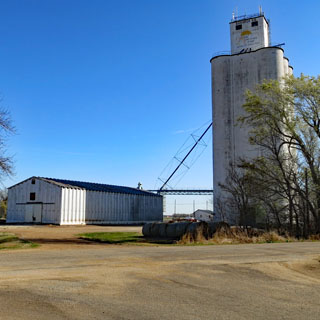
Brookville, Kansas (reached 1867). The town was (for a time) the end of the line and had a significant maintenance depot. For many years, the Brookville Hotel served chicken dinners in the original old building (I've eaten there several times, myself). But, the restaurant moved to Abilene, and the old hotel is gone. Time moves on...

The station of Rock Spring was on the list, but I couldn't find anything by that name. I did see, however, the name Terra Cotta. That must be it; let's go and find it--it's got to be down this road.
This is Terra Cotta, Kansas (assumed to be old Rock Spring). Except for the rail switch (and the utility building) there's nothing left of a town or depot.

Carniero, Kansas. The name is Portuguese for "sheep" or "mutton."
It has a good-sized hotel near the tracks, a few houses and a two story school, but Carniero is mostly empty.


Kannapolis, Kansas. Summit Siding is the name on my list, but it must be Kannapolis, which is on the site of Fort Harker. The fort was established in 1864--so would have been here when the railroad came through.
Ellsworth, Kansas (reached June, 1867).
Ellsworth

What's this? It's the depot for Terra Cotta. How nice. Somebody with an appreciation for history has moved it from its remote location (likely just in time before it was demolished by the railroad) and moved it next to the tracks here in Ellsworth. Good for them. I'll bet not many people who see this building have also been to the original site.
Black Wolf, Kansas. Plenty of grain storage, but not much of a town.
Wilson, Kansas bills itself as the Czech capital of Kansas.
The old opera house is being rebuilt after a recent devastating fire. That's the world's largest Czech egg if you believe the sign.


My lunch might not be authentic Czech (it's authentic Kansas), but the Kolache (koláč) mostly is (poppy seed, of course).

Dorrance, Kansas. Sometimes the only way to photograph a town is to step back.
Bunker Hill, Kansas.
Bunker Hill

Russell, Kansas (reached 1867).
Gorham, Kansas.
Walker, Kansas. The churches in this area have the same yellow stone of the Cotswolds area of England.
Highway 40. Sometimes it's paved within the town, but outside of town, it reverts to dirt. You cannot trust your map to be accurate about this.
Victoria, Kansas.
The Basilica of St. Fidelis was built (or at least finished) in 1911. It's often called The Cathedral of the Plains, but it isn't actually a cathedral.
Hays, Kansas (reached October, 1867).
You can envision the station and all the supporting buildings, but they're gone.
Work continues (in 1867) on the Kansas-Pacific not far west of Hays. Just supplying all these men with food and water must have been an achievement. The needed steel rails and ties must have been continuous with support-trains running back and forth to Kansas City. It's no wonder that towns developed simply to support all this.

Ellis, Kansas (reached 1867).
The station remains...


...as does a bit of the old name "Golden Belt" on that co-op building.

Ellis, Kansas not long after the rails are laid.

Ogallah, Kansas. A photograph of a dirt intersection will have to do.
Wakeeney, Kansas (was Trego). That first name didn't last. A couple of land speculators (Mr. Keeney and Mr. Warren) combined their name, and there you go: Wakeeney. The "Queen City of the High Plains."
Voda, Kansas. The word means "water" in Slavic. This area was settled by Slavs from Russia. Was there really much "Voda" to be found? I'm not sure. In any event, the town doesn't exist, so perhaps not.
Collyer, Kansas.
Collyer

Quinter, Kansas.
Park (was Buffalo Park). Evidently, in 1898 the post office reduced the name to "Park", and that's what you'll see on a road map. It's good to see that today's railroad (Union Pacific) stands by the old name.
Buffalo. There's a reason for the original name. Yes; this is the railroad that was behind those stories you heard in school about shooting thousands of buffalo from the train. Buffalo Bill Cody claimed to have killed 4,280 bison (he was hired by the railroad to do that).

Grainfield, Kansas.
How I'm keeping track...
I had a listing of all the names, along with the
latitude and longitude for those cases to help where the town was not shown on
my road map--and certainly there would be no road signs. Taking this sort
of photograph each time helps me know which shot is from
which town. Yes; they do all look alike.
Grinnell, Kansas.
Campus, Kansas. Just behind me is a new Ethanol plant. The "fresh bread" smell is wonderful.
Oakley, Kansas (was Carlyle).

Monument, Kansas.
I'm almost certain that this building next to the tracks was once the hotel.

Page City, Kansas.
Winona, Kansas.
Along the way...
The Fort Wallace post cemetery. There are no signs of Fort Wallace (it wasn't used long), but the cemetery remains and continued as the cemetery for the town of Wallace (those markers are behind me).
Wallace, Kansas.
That's the railroad section house on the left.

Sharon Springs, Kansas.
Weskan, Kansas (was Monotony). I can see why they might want to change the name from "Monotony", but really, I think they should have kept it as it was.
 Colorado
Colorado
The state line (reached 1870).
That's Arapahoe, Colorado on the horizon.
Cheyenne Wells, Colorado.
The old railroad hotel building still exists (below, right). That's the courthouse on the left.

First View, Colorado. It's tempting to think that this was the first view of the Rocky Mountains, but I think we're still too far for that. Anyway, it's the crest of a fair-sized hill, so it's the first view of something, that's certain.
Kit Carson, Colorado.
Boyero on the horizon. I'm looking for a town (named Mirage) that probably never existed except as a support depot during the construction of the railroad. But, Boyero is in the right spot, so I'm pretty sure this is it.
The Boyero Post Office. That's it. While here, a man drove up to get his mail. I asked about "Mirage" but he hadn't heard of it (his father was also from here and he knew a good deal of the area and its history).
Boyero, Colorado. I was told that this was a good-sized town before the war (on par with Hugo, perhaps larger), but afterwards, it dried up and people moved away. My motorcycle (above) is parked on old U.S. 40. When that highway was moved a few miles east (now U.S. 287)--and particularly when I-70 was built many miles to the north--nobody had any reason to come here, and every reason to leave.
The old service station still has the name.


...on the way. If not for those noisy meadowlarks, it would have been very quiet.
Antelope playing. I didn't see any deer.
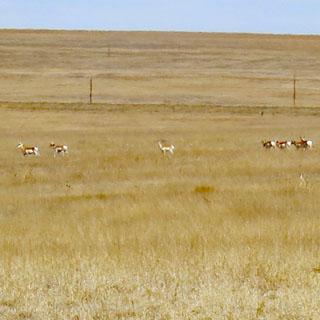
Hugo, Colorado. The rails are on the left. Those clouds are a concern. It has become very windy and is getting colder.
Hugo.

Limon, Colorado (reached 1870). The route of I-70 has now rejoined the route of the rails (and the old Golden Belt Highway).
Limon appreciates its railroad history and has a nice collection of equipment. The old station building is still here, too.


Deer Trail, Colorado. There's a broad area of open land between the rails and the town. Likely there were once multiple rails at this shipping center.
Rails to the west. The wind is now very strong out of the north and it's raining very hard west of me--but that system is developing towards the northeast, so I might be fine. It's odd how the big storms move northeast while the surface wind is simultaneously strong out of the north.
Byers, Colorado. By now, semi-trucks were moving laterally across the lanes without warning and all sorts of big things were blowing across the highway. I parked in front of the hardware store in Byers (the white building farther down), and waited an hour for things to settle down.
That was a good opportunity to talk with the hardware store owner about the history of Byers and the region. It was from him that I learned that the road south out of Bennett had been recently paved its entire length (so my map wasn't correct).
Strasburg, Colorado (was Comanche Crossing) completed August, 1870.
While the Kansas-Pacific was building west towards Denver, another crew was building east to meet them. The two teams met near Comanche Crossing after a frantic last day's competition towards a barrel of whiskey. The winning team put down over ten miles of track in just nine hours--a record.
The meeting of the tracks at Promontory Point Utah is rightly celebrated, but there will always be a footnote that gives credit to Strasburg for being the point where the transcontinental railroad became a reality (and not just a definition).

Bennett, Colorado is the last station before Denver, less than thirty miles away--the Rocky Mountains looming. Today, however, I could tell that Denver was--just this minute--taking quite a beating from the storm.
Denver, Colorado. As with the station in Kansas City, this large Union Station in the center of Denver dates after the Kansas-Pacific made the final connection. In any event, I wasn't risking steady 70 mph winds to see it.

Denver.

And so ends the trip to follow the length of the Kansas-Pacific Railroad. By hitting every stop, I had an appreciation for why the surveyors took the route they did. From the beginning, the rails were hardly ever out of my sight. My viewpoint was therefore as things once were (connected by rail) and not how they are today.
Running south on the Kiowa-Bennett Road and some fresh pavement (and some old, rough pavement). At 60 mph I could put my arm straight out and not even feel a breeze. It's cold, so I'm not too worried about cooling my air-cooled engine (which generally runs cool anyway).
I thought I'd been on all the paved roads in eastern Colorado, so I was pleased to find this new one.
Kiowa, Colorado.
And on and on. The storm behind me is growing (the view is looking back to the north), and seemingly growing towards me, but I'm able to stay in front and only hit sprinkles of rain. I made the right choice to turn south and not try for Denver. On the other hand, there are no hotels anywhere near, should I need to stop for the evening.
Elbert, Colorado.
The Rocky Mountains (Pike's Peak), not far away. A view that has not changed for centuries.
I'm running on county roads that see very little traffic. You have only to look at the grass to see how hard the wind is blowing.
Yoder, Colorado.
Is the road south of Yoder paved all the way? My plan was to stop in Yoder and ask. Trouble is, there doesn't seem to be much of Yoder to call a town. Onward...
Running south, always in front of the rain.
The Boone Road looked pretty good. I was thinking good thoughts that it would be paved all the way. There were no signs to say otherwise.
That is, until I crossed the county line and the pavement ended. Twenty miles of soft dirt and gravel.
Looking back north, into the wind. I'm not riding very fast, and at times I'd let completely off the throttle but still maintain a good pace just by the pushing wind. Keep moving.
A few miles north of Boone the pavement returned. Wonderful! I parked for this shot between two small hills. I had concern that the crosswind (this bit of road points west) would tip the bike over. It was even difficult to stand just to take this picture.
It's not so evident here, but the wind had kicked up dirt and dust so the sky was now brown/yellow; it was as if I were riding in a fog.
Fowler, Colorado. We're now on the route of the Santa Fe Railroad.
La Junta, Colorado has a pretty good little cafe where I've often stopped for breakfast. Their biscuits are recommended.

I am just in time to see the westbound Southwest Chief #3 at the depot.
I'll not bother stopping at every Santa Fe Railroad town on the way back.
Nice trip. You can't make much progress stopping at every town, but that's what the train did, as well.














